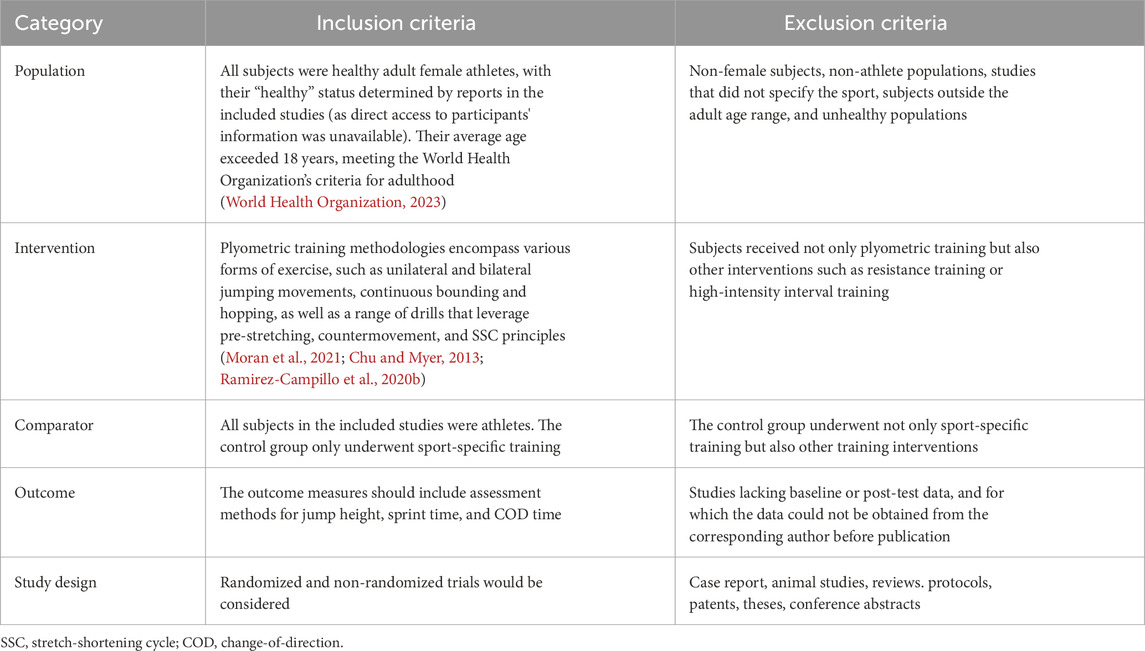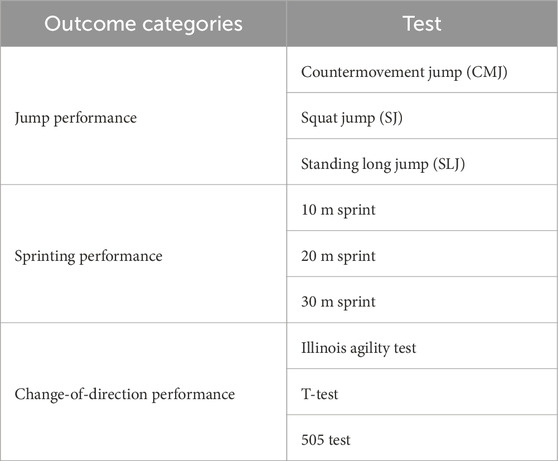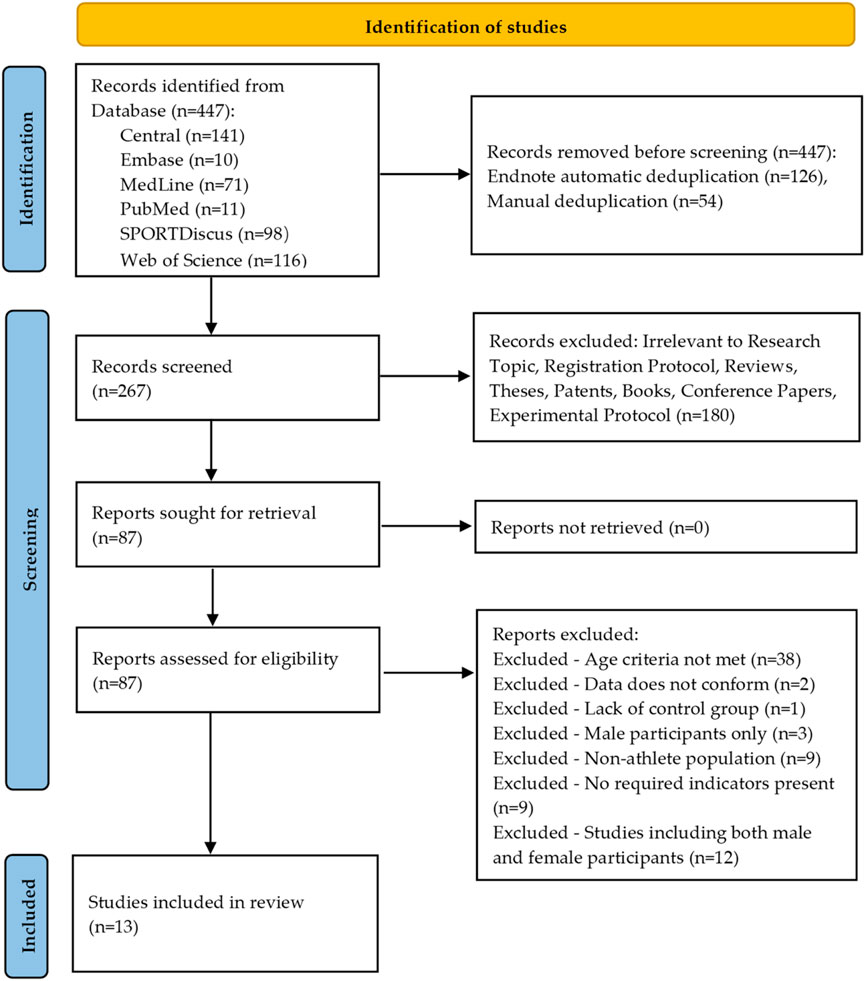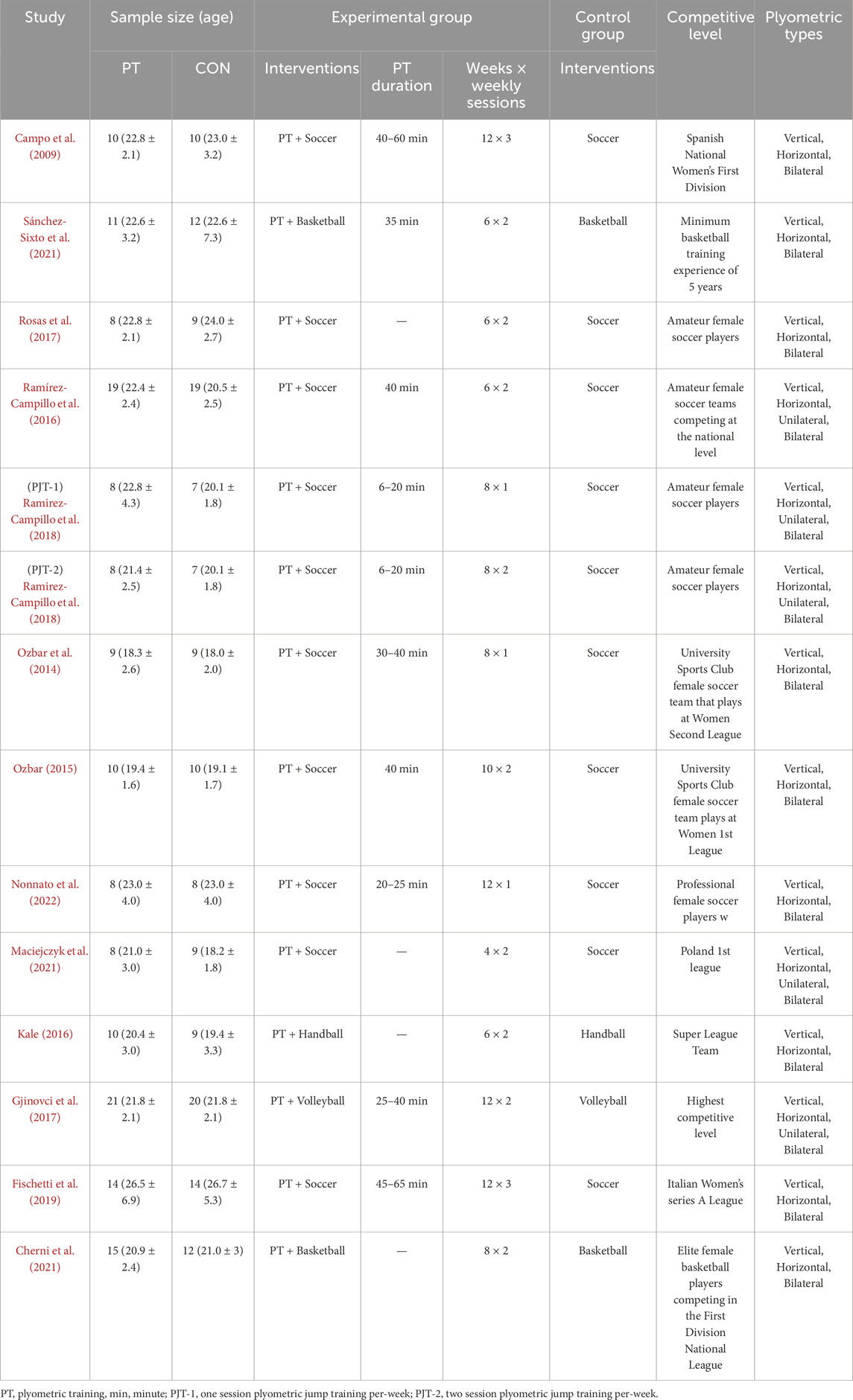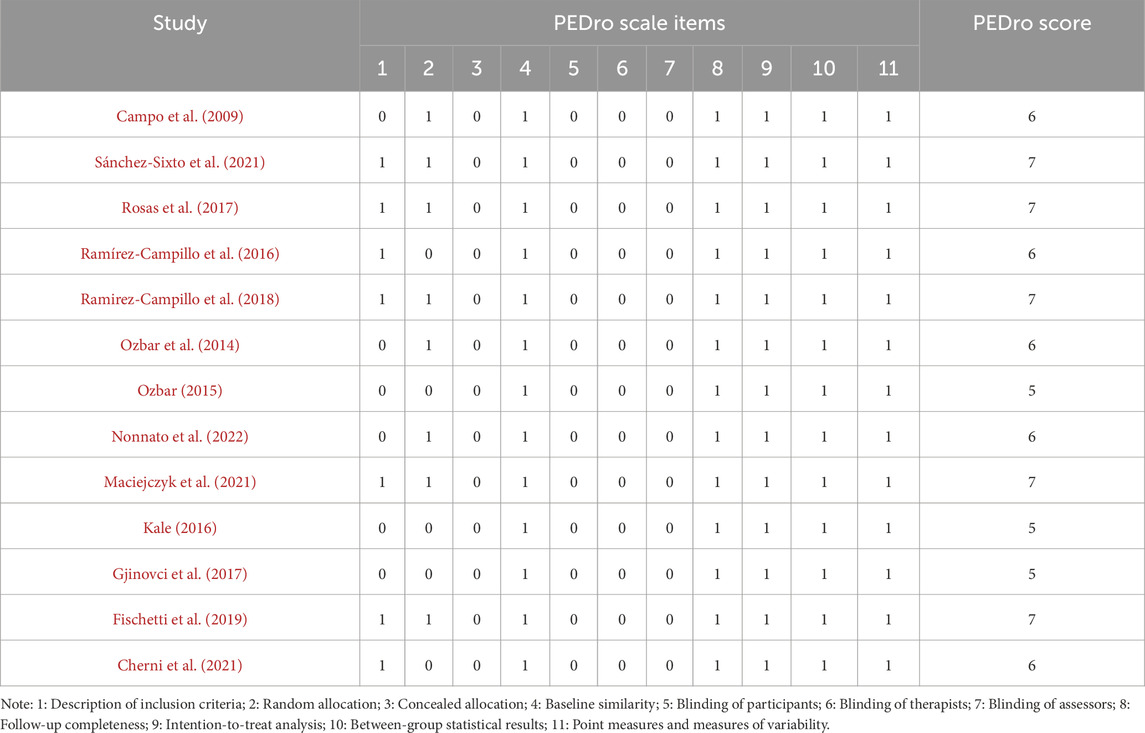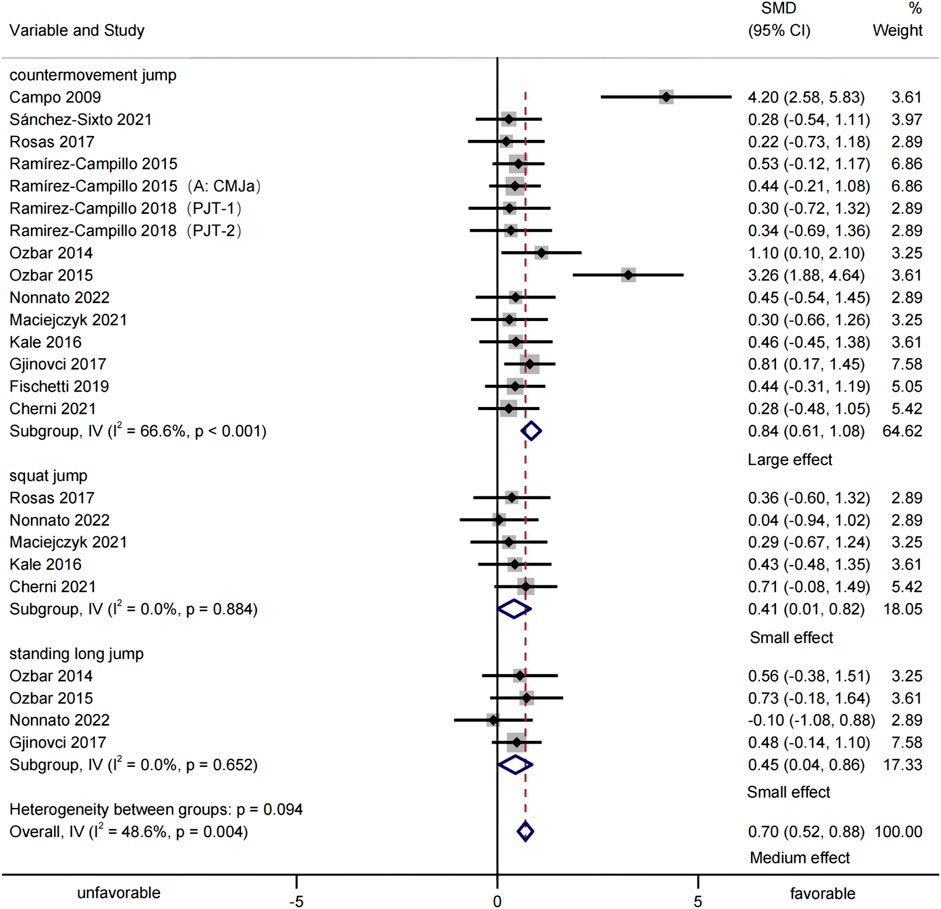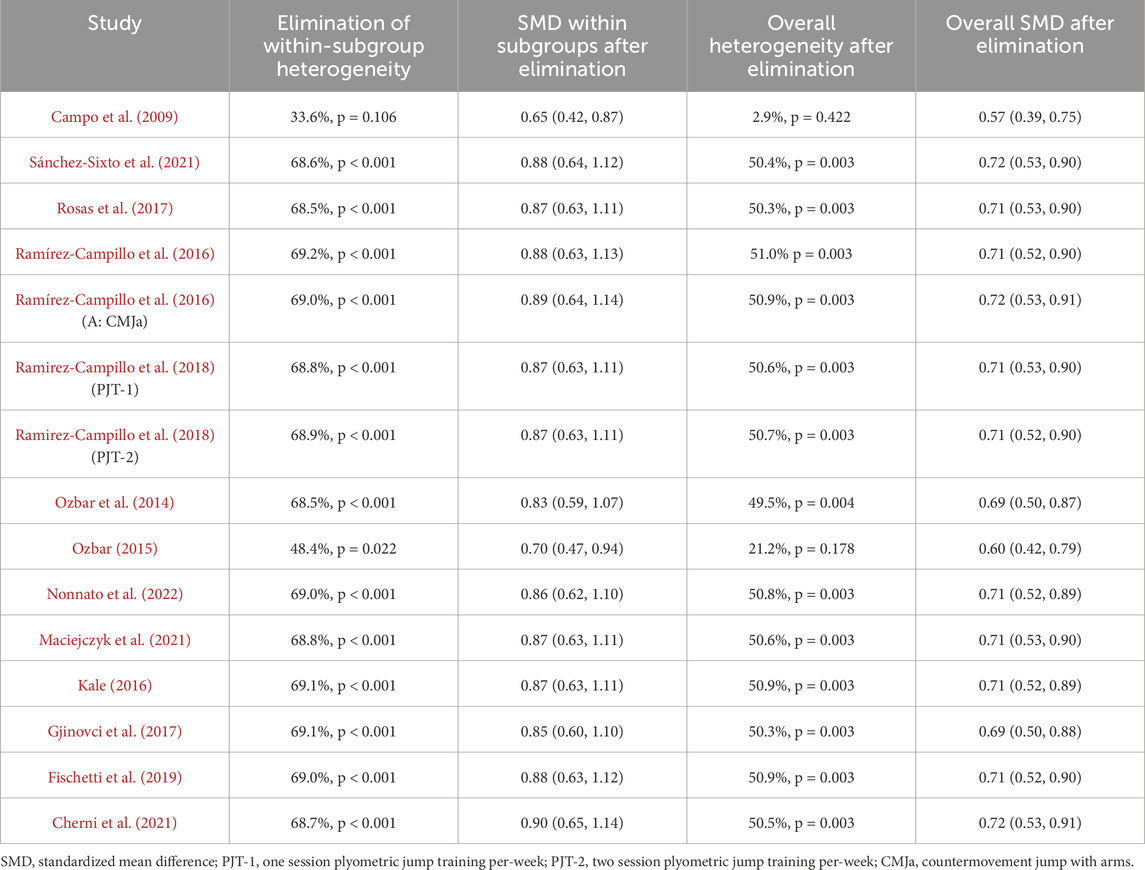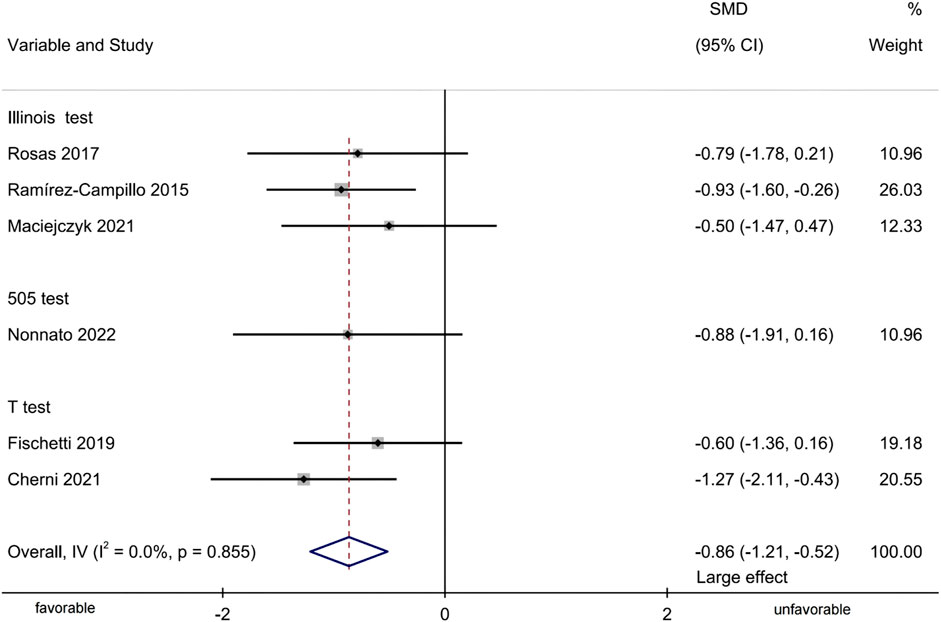- 1College of Physical Education and Health, Guangxi Normal University, Guilin, China
- 2College of Physical Education, China Three Gorges University, Yichang, China
Research on female subjects in sports science remains insufficient, particularly regarding how plyometric training affects adult female athletes’ jumping, sprinting, and change-of-direction (COD) performance. This gap has prevented definitive conclusions about the magnitude and characteristics of such performance effects. This study systematically investigates the impact of plyometric training on adult female athletes' jumping, sprinting, and COD performance. A comprehensive literature search was conducted across PubMed, Web of Science (including all databases), MEDLINE, Cochrane Central Register of Controlled Trials (CENTRAL), Embase, and SPORTDiscus, with the search time frame extending from the inception of each database to 10 May 2025. Data analysis was performed using Stata 15 software, and the methodological quality of the included studies was assessed using the PEDro scale. The results indicate that plyometric training significantly enhances the jumping performance (SMD = 0.70, p < 0.001, medium effect), sprinting performance (SMD = −0.61, p < 0.001, medium effect), and COD performance (SMD = −0.86, p < 0.001, large effect) of adult female athletes. Subgroup analysis further reveals that plyometric training significantly improves countermovement jump (CMJ; SMD = 0.84, p < 0.001, large effect), squat jump (SJ; SMD = 0.41, p = 0.046, small effect), and standing long jump (SLJ; SMD = 0.45, p = 0.031, small effect) performance, as well as sprinting performance over distances of 10 m (SMD = −0.55, p = 0.016, medium effect), 20 m (SMD = −0.55, p = 0.002, medium effect), and 30 m (SMD = −0.72, p = 0.002, medium effect). This study demonstrates that plyometric training effectively improves the jumping, sprinting, and COD performance of adult female athletes. It is recommended that coaches and athletes incorporate plyometric training into their specialized training programs to optimize sport performance and training outcomes in female athletes.
Introduction
The significance of jumping, sprinting, and change-of-direction (COD) performance for athletes cannot be overstated, as these abilities are fundamental to numerous sports and often serve as key determinants of athletic competitiveness (Lloyd et al., 2016). For basketball players, frequent direction changes and jumps are necessary for rapid transitions between offense and defense (Svilar et al., 2018). Volleyball players need to jump frequently to spike and block (Powers, 1996). Soccer players usually have to sprint repeatedly to break away from opponents and create scoring chances (von Lieres Und Wilkau et al., 2020). Beyond their role in specific sport performance, these abilities also significantly impact athletes’ overall physical fitness and match adaptability (Haugen et al., 2019). These movements are not only practical indicators of athletic prowess, but also rooted in neuromuscular adaptations, such as motor unit recruitment efficiency and intermuscular coordination, which are critical for explosive force production (Cannon and Cafarelli, 1987). Therefore, a training method that can effectively enhance jumping, sprinting, and COD performance is essential.
Plyometric training is a scientifically proven, highly effective method to enhance jumping, sprinting, and COD performance, with wide application across sports (Ramirez-Campillo et al., 2020a; Chen et al., 2024; Chen et al., 2023a; Zhang et al., 2025; Asadi, 2013; Váczi et al., 2013; Chaabene et al., 2021). Numerous systematic reviews and meta-analyses have also reached the same conclusion. For example, Sáez-Sáez de Villarreal et al. (2010) confirmed the effectiveness of plyometric training on strength performance, Markovic (2007) verified its effectiveness on vertical jump height, and Asadi et al. (2016) demonstrated its effectiveness on COD performance. The high efficacy of plyometric training is attributed to a unique physiological mechanism known as the stretch-shortening cycle (SSC), which comprises three phases: eccentric, isometric, and concentric. This brief isometric phase acts as a transitional period to maintain muscle tension before the concentric phase (Turner and Jeffreys, 2010). During the eccentric phase, muscles lengthen under load and store elastic potential energy, rapidly released during the subsequent concentric phase when the transition between eccentric and concentric phases is rapid (Asmussen and Bonde-Petersen, 1974; Cavagna et al., 1965). During the eccentric phase, muscles utilize the stretch reflex mechanism to augment the force produced during the concentric contraction, where rapid lengthening of muscles activates sensory receptors to trigger a more forceful concentric contraction (Bosco et al., 1982; Bosco and Komi, 1979; Chen et al., 2023b). This mechanism aligns with fundamental biomechanical principles of force transfer and impulse generation, optimizing movement efficiency by synchronizing elastic energy utilization and neuromuscular activation (Kallerud and Gleeson, 2013). Therefore, plyometric training is a broadly effective physical training method that can optimize sport performance.
Although the efficacy of plyometric training is widely recognized, the representation of female athletes in sports science research remains severely limited (Paul et al., 2023). A review by Paul et al. (2023) demonstrated that from 2017 to 2021, among the top six sports medicine journals, 70.7% of studies focused on male subjects, while only 8.8% were centered on female subjects. This underrepresentation is also evident in research on plyometric training, where the effects of such training on female subjects remain inconclusive (Chen et al., 2025a). Chen et al. (2025a), in their study on plyometric training, similarly emphasized the need for increased attention to female subjects due to their scarcity in research. Female-specific factors like hormonal variations (e.g., estrogen fluctuations) may modulate neuromuscular responses to plyometric stimuli, altering motor unit firing patterns and muscle activation thresholds (Sieck and Mantilla, 2004). Such sex-related differences in training adaptations are not unique to plyometrics; as (Roberts et al. (2020) noted in their systematic review, resistance training induces similar effects on muscle hypertrophy and lower limb strength gains in males and females. Yet, females exhibit greater improvements in upper limb strength compared to males. This further supports that physiological disparities can lead to divergent training outcomes between sexes. Biomechanically, differences in lower limb kinematics and joint stiffness between sexes could also affect SSC dynamics, influencing performance gains and injury risk profiles (Hewett et al., 2005).
Given the critical importance of jumping, sprinting, and COD performance for athletes; the established efficacy of plyometric training in enhancing these abilities; and the uncertainty surrounding the effects of plyometric training on female subjects, this study aims to systematically investigate the impact of plyometric training on the jumping, sprinting, and COD performance of adult female athletes. It is hoped that the findings will provide robust support for the plyometric training practices of female athletes.
Methods
Eligibility criteria
This systematic review and meta-analysis was conducted by the PICOS (Participants, Interventions, Comparisons, Outcomes, and Study design) principles to establish the criteria for the inclusion and exclusion of studies. The specific inclusion and exclusion criteria are detailed in Table 1.
Search strategy
This systematic review and meta-analysis comprehensively searched six authoritative databases: PubMed, Web of Science (all databases), MEDLINE, CENTRAL, Embase, and SPORTDiscus. The search was limited to the period from the inception of each database to 10 May 2025. The search topics focused on plyometric training, females, athletes, jumping, sprinting, and change-of-direction, with Boolean logic operators (“OR” and “AND”) used to connect search terms across different themes. The study has been registered in the International Prospective Register of Systematic Reviews (PROSPERO: CRD420251049911), and the registration protocol can be accessed via the following link: https://www.crd.york.ac.uk/PROSPERO/view/CRD420251049911. The specific search strategy is detailed in Table 2, and the complete search details for all databases are provided in Supplementary Material S1 for reference.
Data extraction
The data extraction process involved three co-authors and focused on two main themes: data extraction and extraction of study characteristics. Data extraction was conducted by two co-authors (R.Z and J.Y.), who collected the means and standard deviations of both baseline and post-intervention data. Extraction of study characteristics was also performed by two co-authors (R.Z. and J.Y.), who gathered information on the first author, publication year, sample size, participant age, sport specialization, intervention duration, intervention frequency, and duration of each training session. Data extraction forms are provided in Supplementary Material S3 for reference. After completing the data and study characteristic extractions, the two co-authors (R.Z. and J.Y.) cross-checked their extracted information. In the event of discrepancies, a third co-author (Y.D.) made the final decision. The GetData software was utilized to extract unconventional data, such as that presented in error bars or bar charts. If baseline and post-intervention data could not be directly obtained or indirectly extracted using GetData, one co-author (R.Z.) contacted the corresponding authors of the included studies via email or the ResearchGate platform to request the data. If the data could not be obtained prior to publication, the study was excluded. Outcome metrics are detailed in Table 3.
Methodological quality of the included studies
The methodological quality of all studies included in this systematic review and meta-analysis was assessed using the PEDro scale. The PEDro scale ranges from 0 to 10, with higher scores indicating better methodological quality. The methodological quality assessment was independently conducted by two co-authors (R.Z. and J.Y.), and the results were verified and finalized by a third co-author (Y.D.). The methodological quality ratings on the PEDro scale are interpreted as follows: poor (<4), fair (4–5), good (6–8), and excellent (9–10).
Risk of bias assessment
The Rob 2.0 framework (Revised Cochrane Risk of Bias Tool for Randomized Trials) was employed to evaluate the risk of bias in this study. This tool assesses multiple key domains, including the generation of random sequences, the concealment of allocations, blinding procedures, handling of missing outcome data, and selective reporting of outcomes (Sterne et al., 2019).
Based on the methodological reliability, the studies were classified into three distinct levels:
1. Low risk of bias: All assessed domains were determined to be at low risk.
2. High risk of bias: The presence of any domain rated as high risk resulted in this classification.
3. Some concerns: This category applied to studies that did not meet the low or high risk of bias criteria.
Two co-authors (R.Z. and J.Y.) independently carried out the assessment process. In cases where discrepancies arose, a third co-author (Y.D.) was consulted to provide final arbitration and resolve the disagreements.
Synthesis methods
Data analysis for this systematic review and meta-analysis was conducted using Stata (Release 15; StataCorp, United States). To avoid bias resulting from the omission of baseline scores in the pooled analysis, both baseline and post-intervention scores were included in the forest plots to ensure accurate reporting of results. Given the variability in testing equipment and protocols, the standardized mean difference (SMD) with a 95% confidence interval was used to calculate the pooled effect sizes, with p < 0.05 indicating statistical significance. The effect size of SMD can be interpreted as follows: trivial (SMD < 0.20), small (0.20 ≤ SMD < 0.50), medium (0.50 ≤ SMD < 0.80), and large (SMD ≥ 0.80) (Hedges and Olkin, 2014). Since all participants in the included studies were athletes, the potential confounding effects of sport-specific training were considered. Therefore, this study included the baseline and post-intervention means and standard deviations for the experimental and control groups. To better assess the effects of the intervention between the two groups, we artificially converted the data into change scores and standard deviations. The calculation formula is as follows:
Results
Study selection
The study selection process was strictly conducted according to the inclusion and exclusion criteria, with the specific workflow presented in Figure 1. The initial search yielded a total of 447 studies. EndNote software was used for automatic and manual exclusion of duplicates, with 126 studies automatically removed and an additional 54 studies manually excluded. After removing duplicates, the remaining studies were screened based on their titles and abstracts. One hundred eighty studies were excluded at this stage, with the reasons for exclusion detailed in Figure 1. Of these, 74 studies were excluded due to the following reasons: age criteria not met, data not conforming (e.g., the study by Paktas (2021) only reported means without accompanying standard deviations), lack of a control group, male participants only, non-athlete population, no required indicators present (e.g., the study by Alikhani (Alikhani et al., 2019) did not include the tests outlined in Table 3), and studies including both male and female participants. Ultimately, 13 studies were included in the analysis. The reasons for inclusion and exclusion for all downloaded studies are documented and provided in Supplementary Material S2 for reference.
Description of the included studies
This systematic review and meta-analysis strictly adhered to the inclusion and exclusion criteria based on the PICOS principles, ultimately including 13 studies for statistical analysis (Table 4). All participants in the included studies were adult female athletes, with the lowest mean age in the experimental groups being 18.3 ± 2.6 years and the highest being 26.5 ± 6.9 years. In all studies, the experimental groups underwent plyometric training in addition to their specific sport training, while the control groups participated in the same sport-specific training without plyometric training.
Methodological quality of the included studies
The methodological quality of all included studies was assessed using the PEDro scale (Table 5). Three studies scored five points (Ozbar, 2015; Kale, 2016; Gjinovci et al., 2017), indicating fair methodological quality. The remaining nine studies scored over six points, indicating good methodological quality. The overall average score of the 13 included studies was 6.15, indicating good methodological quality overall.
Risk of bias
Overall, all included studies were rated as having a moderate risk of bias. Specifically, eight studies (61.5%) reported the randomization process, while five (38.5%) did not mention the randomization process. One study (7.7%) was rated as having a moderate risk of bias in the domain of outcome measurement. The selection of reported results was unclear for all included studies and was therefore marked as “some concerns.” For detailed information, refer to Figure 2.
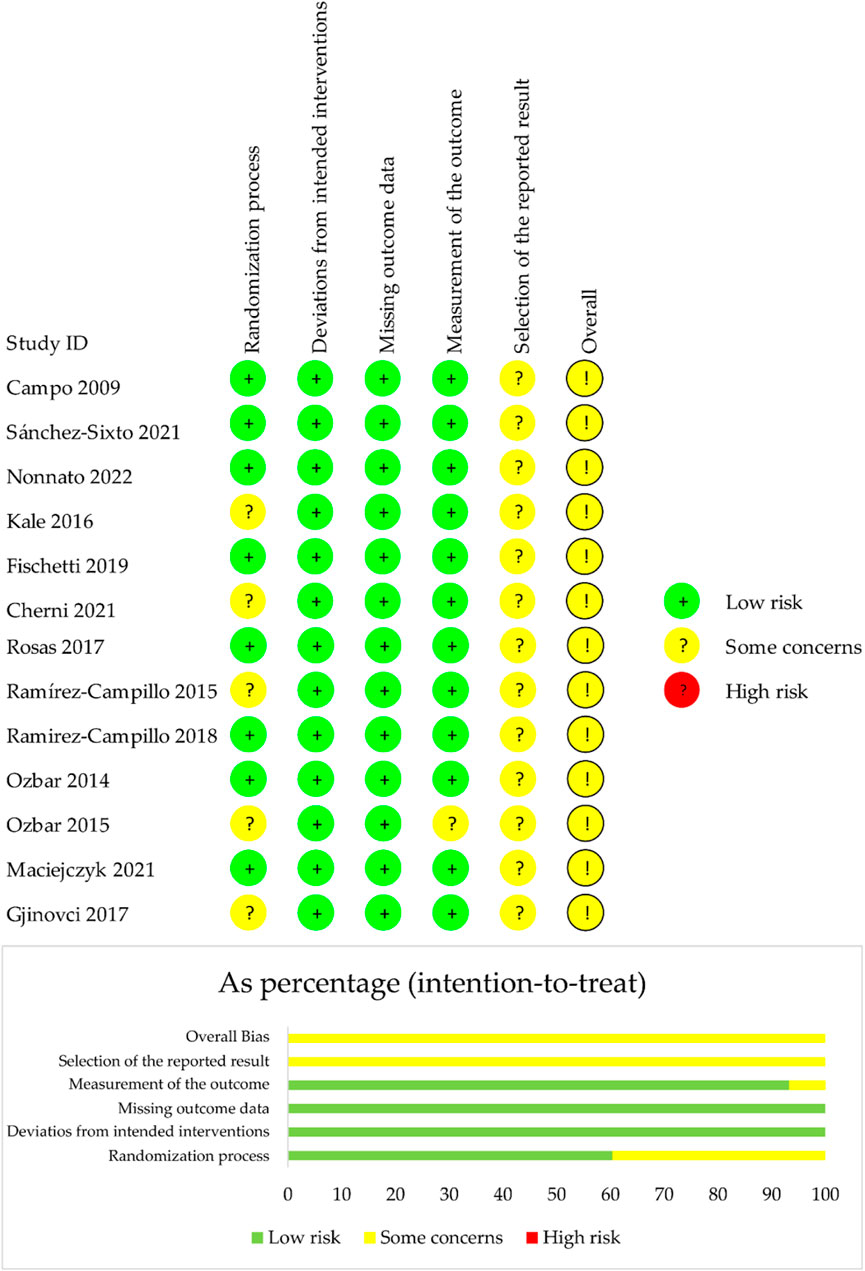
Figure 2. Overall risk of bias presented as percentage of each risk of bias item across all included studies.
Publication bias
Visual inspection of the funnel plots suggested potential publication bias in studies reporting on jumping and sprinting performance (Figure 3). Egger’s test confirmed publication bias for jumping performance (t = 2.42, p = 0.024). However, the trim-and-fill method indicated that no additional studies needed to be added, providing some support for the stability of the observed effects. No publication bias was detected for sprinting performance (t = 0.39, p = 0.703) or COD performance (t = 0.38, p = 0.723).

Figure 3. Visualization of Publication and Bias, Egger’s Test [(A) Funnel plot for jumping performance; (B) Egger’s Test for jumping performance; (C) Funnel plot for sprinting performance; (D) Egger’s Test for sprinting performance; (E) Funnel plot for COD performance; (F) Egger’s Test for COD performance].
Meta-analysis results
Jump performance
Thirteen studies were included, providing 24 groups of jumping-test data to assess the effects of plyometric training on adult female athletes’ jumping performance (Figure 4). Meta-analysis showed that plyometric training significantly improved jumping performance [SMD = 0.70, 95% CI (0.52, 0.88), p < 0.001, medium effect], with moderate heterogeneity (I2 = 48.6%, p = 0.004). Subgroup analysis indicated significant improvements in CMJ [SMD = 0.84, 95% CI (0.61, 1.08), p < 0.001, I2 = 66.6%, large effect], SJ [SMD = 0.41, 95% CI (0.01, 0.82), p = 0.046, I2 = 0.0%, small effect], and SLJ [SMD = 0.45, 95% CI (0.04, 0.86), p = 0.031, I2 = 0.0%, small effect]. For the CMJ subgroup, the stepwise exclusion method found that after excluding Campo et al. (2009), heterogeneity reduced (I2 = 33.6%, p = 0.106) without result reversal [SMD = 0.65, 95% CI (0.42, 0.87), p < 0.001]. Overall heterogeneity was non-significant (I2 = 2.9%, p = 0.422), and the overall result remained unchanged [SMD = 0.57, 95% CI (0.39, 0.75), p < 0.001]. Thus, Campo et al. (2009) was the main heterogeneity source, but the results remained robust despite heterogeneity (Table 6).
Sprint performance
Eight studies were included, providing 15 groups of sprint-test data to assess the effects of plyometric training on adult female athletes' sprinting performance (Figure 5). Meta-analysis showed that plyometric training significantly improved sprinting performance [SMD = −0.61, 95% CI (−0.83, −0.39), p < 0.001, medium effect], with non - significant heterogeneity (I2 = 37.5%, p = 0.071). Subgroup analysis indicated significant improvements in 10 - m [SMD = −0.55, 95% CI (−1.01, −0.10), p = 0.016, I2 = 46.7%, medium effect], 20 - m [SMD = −0.55, 95% CI (−0.89, −0.20), p = 0.002, I2 = 45.5%, medium effect], and 30 - m sprints [SMD = −0.72, 95% CI (−1.10, −0.34), p = 0.002, I2 = 43.9%, medium effect].
Change-of-direction performance
Six studies were included, providing six groups of COD-test data to assess the effects of plyometric training on adult female athletes’ COD performance (Figure 6). Meta-analysis showed that plyometric training significantly improved COD performance [SMD = −0.86, 95% CI (−1.21, −0.52), p < 0.001, large effect), with no heterogeneity observed (I2 = 0.0%, p = 0.855). Notably, the presentation of COD performance data here reflects subgrouping by test indicators rather than formal subgroup analyses. Given the small number of studies (n = 6) contributing to this subgroup, the certainty of these findings is limited.
Sensitivity analysis
The sensitivity analysis results indicated that for jump performance, the studies by Campo et al. (2009) (SMD = 0.50) and Ozbar (2015) (SMD = 0.50) introduced considerable deviations. However, the overall results did not exhibit bias or reversal. For sprint performance and COD performance, all results did not introduce substantial deviations, suggesting that despite the presence of heterogeneity and some concerns regarding the risk of bias, these factors did not undermine the robustness of the results. This finding indicates that the results are relatively robust. The sensitivity analysis results have been uploaded to the supplementary materials (S4-Sensitivity Analysis Results) for reference.
Discussion
Based on the included study data, the present study further quantified, via meta-analysis, the overall effects of plyometric training on adult female athletes, and the meta-analysis results indicated that: plyometric training is a highly effective conditioning method for adult female athletes, significantly enhancing jumping (SMD = 0.70, p < 0.001, medium effect), sprinting (SMD = −0.61, p < 0.001, medium effect), and COD performance (SMD = −0.86, p < 0.001, large effect). Subgroup analyses show significant improvements in CMJ (SMD = 0.84, p < 0.001, large effect), SJ (SMD = 0.41, p = 0.046, small effect), and SLJ (SMD = 0.45, p = 0.031, small effect) for jumping, and in 10-m (SMD = −0.55, p = 0.016, medium effect), 20-m (SMD = −0.55, p = 0.002, medium effect), and 30-m (SMD = −0.72, p = 0.002, medium effect) sprints. However, due to the limited number of studies on COD performance, subgroup pooled effects were not calculated. These findings carry substantial importance as they validate plyometrics as a pivotal tool for female athletes, addressing the longstanding gap in sex-specific performance enhancement research. For training regimens, this underscores the need to integrate such protocols tailored to women’s neuromuscular profiles, ensuring optimized gains in key athletic capacities.
The efficacy of plyometric training in enhancing sport performance has been well-established, with its significant positive effects on jumping, COD, and sprinting performance supported by numerous studies (Ramirez-Campillo et al., 2020a; Chen et al., 2023a; Ramirez-Campillo et al., 2020b). While previous research has sought to generalize its applicability across different sex (Chen et al., 2025a; Stojanović et al., 2017), ages groups (Ramírez-Campillo et al., 2016; Vetrovsky et al., 2019), and training levels (Ramirez-Campillo et al., 2018; Deng et al., 2024; Huang et al., 2023; Chelly et al., 2014), much of this evidence stems from male-centric samples—such as the work by Moran et al. (2024) demonstrated its benefits in improving jumping, sprinting, and COD abilities in adult male soccer players. Despite differences in study populations, the consistent core outcomes highlight the generalizability of plyometric training across various athletic abilities. This generalizability is attributed to several neuromuscular adaptations, including enhanced SSC efficiency (i.e., improved elastic energy storage during eccentric lengthening, rapid release during concentric shortening, and faster phase transitions to amplify force output), altered activation strategies of agonist and antagonist muscles, improved muscle excitability due to SSC (Chen et al., 2023b; Stojanović et al., 2017; Markovic and Mikulic, 2010; Ullrich et al., 2018; Blazevich et al., 2003; Ullrich et al., 2018; Grosset et al., 2009; Kubo et al., 2007; Cornu et al., 1997; Fouré et al., 2009), and changes in muscle structure, such as increased muscle volume (McGarrigal et al., 2025; Edwén et al., 2014).
However, the underrepresentation of female subjects in sports science research continues to obscure the definitive effects of plyometric training on female participants (Paul et al., 2023). As early as 2019, Moran et al. (2019) highlighted the scarcity of research on plyometric training for females. Although their study confirmed its effectiveness in enhancing jumping performance in adolescent females, they also noted that unpublished and non-peer-reviewed studies dominated their collected literature. This underscores the paucity of research on females and limits the interpretability and strength of evidence in their findings. As of 2025, Chen et al. (2025a) continued to advocate for the importance of female-focused research in their study on plyometric training. Building on Moran et al. (2019), Chen et al. (2025a) further showed that plyometric training enhances jumping performance in adolescent females and improves sprinting performance. In response to the calls from Moran et al. (2019) and Chen et al. (2025a), this systematic review and meta-analysis focuses on female participants. Unlike their studies, which primarily targeted adolescent females, this review and meta-analysis specifically concentrated on adult female athletes. This work serves as a comprehensive supplement to the existing literature on plyometric training in females. Unlike previous studies, this systematic review and meta-analysis provide a holistic assessment of the effects of plyometric training on jumping, sprinting, and COD performance in adult female athletes. Our findings confirm the overall efficacy of plyometric training in enhancing these sports performance in adult female athletes, thereby further enriching the research landscape in this domain.
When discussing female subjects, it is inevitable to compare their training adaptations with those of male subjects. Although the number of studies included in this systematic review is limited, this an interesting and worthwhile topic for discussion. However, to our knowledge, only two similar studies currently exist. Thus, conclusions regarding sex differences in training adaptations between males and females, and their underlying mechanisms are extremely limited. Ramírez-Campillo et al. (2016) compared the training adaptations of male and female soccer players following plyometric training. Their results indicated that plyometric training significantly enhanced jumping, sprinting, and COD performance in both male and female participants, with no significant differences observed between the groups. The only potential difference may be that females exhibited superior potential injury-reducing effects compared to males (Ter Stege et al., 2014). In another study, Marzouki et al. (2022) compared the sex differences in the effects of plyometric training on school-aged children and adolescents. Similar to the findings of Ramírez-Campillo et al. (2016), they observed no significant differences between male and female participants in the U8 and U10 age groups. However, among the U12 population, male adolescents demonstrated significantly greater adaptations to plyometric training than their female counterparts. The normal physiological development of females may explain this phenomenon. Specifically, U12 girls may enter puberty, during which increased estrogen secretion can lead to an increase in fat tissue, thereby reducing cardiopulmonary efficiency. Fat mass represents an inert, non-contributing load that may impair biomechanical movement efficiency and potentially hinder motor proficiency (Panayiotes et al., 2012; Dumith et al., 2010; D’Hondt et al., 2009). Although no specific recommendations are available solely for females, the study by Chen et al. (2023b) provides comprehensive training suggestions. For enhancing CMJ performance, the total number of ground contacts should be limited to fewer than 900, with a recommended total training time of 500–600 min. In contrast, for improving SJ performance, the total number of ground contacts should exceed 1,400, with a total training time of 400–500 min.
In sports science, heterogeneity among studies is often inevitable (Chen et al., 2025b), as seen in the moderate heterogeneity in the CMJ subgroup for jumping performance here. Though both the overall jumping group and CMJ subgroup showed moderate heterogeneity, the leave-one-out method revealed excluding Campo et al. (2009) eliminated significant heterogeneity in both. Notably, the results remained consistent, indicating that the study by Campo et al. (2009) was the primary source of heterogeneity. Thus, even with the presence of heterogeneity in both the overall and subgroup analyses, the robustness of the meta-analysis results was maintained. Similarly, the sensitivity analysis also demonstrated that, despite the presence of heterogeneity and some concerns regarding the risk of bias, no significant deviations or reversals were observed in the overall validity of the results, thereby confirming the overall stability of our findings.
Limitations and future direction
In this systematic review and meta-analysis, the limited number of included studies restricted our analysis to independently examining the efficacy of plyometric training on sprinting, jumping, and COD performance in adult female participants. This limitation precluded a comprehensive assessment of potential sex differences in the effects of plyometric training between male and female subjects. Consequently, the unique impact of sex on training outcomes may have been obscured. Additionally, the scarcity of studies involving healthy adult females who are not athletes meant that our statistical analysis could not include this representative and broadly applicable population. This diminishes the generalizability of our findings to the general population and highlights a gap in current research focus. Furthermore, the included studies exhibited substantial variability in intervention protocols—such as differences in training intensity, duration, frequency, and specific plyometric exercises—and critical gaps in reporting key training details (e.g., progression models, rest intervals, or exercise form standardization), which not only introduces heterogeneity but also limits our ability to link specific training components to outcomes. Another limitation is the omission of certain performance tests commonly used in plyometric research (e.g., reactive strength index tests, drop jump height at various loads) from the included studies, which restricted our ability to analyze a broader spectrum of neuromuscular adaptations. Additionally, subgroup analyses were constrained by small sample sizes in specific subgroups (e.g., sprint distances <10 m, advanced-level athletes), reducing statistical power to detect meaningful differences. Methodological differences in performance testing across studies also pose challenges: for CMJ specifically, variations in testing protocols (e.g., countermovement depth, arm swing allowance, or equipment used for force/velocity measurement) were not consistently reported, which may introduce bias in pooled outcomes. More broadly, inconsistencies in timing of assessments (e.g., post-training testing windows) further limit comparability.
Despite the emphasis on the importance of female-focused research by Moran et al. (2019) and Chen et al. (2025a), studies on female subjects in plyometric training remain underrepresented. This neglect not only limits our understanding of how females respond to and adapt to such training but may also result in developing training programs lacking specificity and scientific rigor. Therefore, this systematic review and meta-analysis reiterate the urgent need for future research to prioritize studies involving female participants. This call to action extends beyond plyometric training to other exercise modalities, where female subjects are similarly underrepresented.
Conclusion
The results of this systematic review and meta-analysis demonstrate that plyometric training is an effective means of enhancing jumping, sprinting, and COD performance in adult female athletes. Therefore, incorporating plyometric training into training programs represents a scientifically sound and practical approach to improve sport performance in this population.
Author contributions
RZ: Conceptualization, Data curation, Formal Analysis, Investigation, Methodology, Project administration, Software, Supervision, Validation, Visualization, Writing – original draft, Writing – review and editing. JY: Conceptualization, Formal Analysis, Project administration, Supervision, Writing – original draft, Writing – review and editing. YD: Investigation, Methodology, Project administration, Visualization, Writing – original draft, Writing – review and editing.
Funding
The author(s) declare that no financial support was received for the research and/or publication of this article.
Conflict of interest
The authors declare that the research was conducted in the absence of any commercial or financial relationships that could be construed as a potential conflict of interest.
Generative AI statement
The author(s) declare that no Generative AI was used in the creation of this manuscript.
Any alternative text (alt text) provided alongside figures in this article has been generated by Frontiers with the support of artificial intelligence and reasonable efforts have been made to ensure accuracy, including review by the authors wherever possible. If you identify any issues, please contact us.
Publisher’s note
All claims expressed in this article are solely those of the authors and do not necessarily represent those of their affiliated organizations, or those of the publisher, the editors and the reviewers. Any product that may be evaluated in this article, or claim that may be made by its manufacturer, is not guaranteed or endorsed by the publisher.
Supplementary material
The Supplementary Material for this article can be found online at: https://www.frontiersin.org/articles/10.3389/fphys.2025.1633089/full#supplementary-material
Abbreviations
SSC, stretch-shortening cycle; CMJ, countermovement jump; CMJa, countermovement jump with arms; SJ, squat jump; SLJ, standing long jump; VJ, vertical jump; COD, change-of-direction; 10 m, 10 m sprint; 20 m, 20 m sprint; 30 m, 30 m sprint; PT, plyometric training, min, minute; PJT-1, one session plyometric jump training per-week; PJT-2, two session plyometric jump training per-week; SMD, standardized mean difference.
References
Alikhani R., Shahrjerdi S., Golpaigany M., Kazemi M. (2019). The effect of a six-week plyometric training on dynamic balance and knee proprioception in female badminton players. J. Can. Chiropr. Assoc. 63 (3), 144–153.
Asadi A. (2013). Effects of in-season short-term plyometric training on jumping and agility performance of basketball players. Sport Sci. Health 9, 133–137. doi:10.1007/s11332-013-0159-4
Asadi A., Arazi H., Young W. B., de Villarreal E. S. (2016). The effects of plyometric training on change-of-direction ability: a meta-analysis. Int. J. Sports Physiology Perform. 11 (5), 563–573. doi:10.1123/ijspp.2015-0694
Asmussen E., Bonde-Petersen F. (1974). Storage of elastic energy in skeletal muscles in man. Acta Physiol. Scand. 91 (3), 385–392. doi:10.1111/j.1748-1716.1974.tb05693.x
Blazevich A. J., Gill N. D., Bronks R., Newton R. U. (2003). Training-specific muscle architecture adaptation after 5-wk training in athletes. Med. Sci. Sports Exerc. 35 (12), 2013–2022. doi:10.1249/01.MSS.0000099092.83611.20
Bosco C., Komi P. V. (1979). Potentiation of the mechanical behavior of the human skeletal muscle through prestretching. Acta Physiol. Scand. 106 (4), 467–472. doi:10.1111/j.1748-1716.1979.tb06427.x
Bosco C., Ito A., Komi P., Luhtanen P., Rahkila P., Rusko H., et al. (1982). Neuromuscular function and mechanical efficiency of human leg extensor muscles during jumping exercises. Acta Physiol. Scand. 114 (4), 543–550. doi:10.1111/j.1748-1716.1982.tb07022.x
Campo S. S., Vaeyens R., Philippaerts R. M., Redondo J. C., de Benito A. M., Cuadrado G. (2009). Effects of lower-limb plyometric training on body composition, explosive strength, and kicking speed in female soccer players. J. Strength Cond. Res. 23 (6), 1714–1722. doi:10.1519/jsc.0b013e3181b3f537
Cannon R., Cafarelli E. (1987). Neuromuscular adaptations to training. J. Appl. Physiology 63 (6), 2396–2402. doi:10.1152/jappl.1987.63.6.2396
Cavagna G., Saibene F., Margaria R. (1965). Effect of negative work on the amount of positive work performed by an isolated muscle. J. Appl. Physiology 20 (1), 157–158. doi:10.1152/jappl.1965.20.1.157
Chaabene H., Negra Y., Moran J., Prieske O., Sammoud S., Ramirez-Campillo R., et al. (2021). Plyometric training improves not only measures of linear speed, power, and change-of-direction speed but also repeated sprint ability in young female handball players. J. Strength Cond. Res. 35 (8), 2230–2235. doi:10.1519/JSC.0000000000003128
Chelly M. S., Hermassi S., Aouadi R., Shephard R. J. (2014). Effects of 8-week in-season plyometric training on upper and lower limb performance of elite adolescent handball players. J. Strength Cond. Res. 28 (5), 1401–1410. doi:10.1519/JSC.0000000000000279
Chen L., Zhang Z., Huang Z., Yang Q., Gao C., Ji H., et al. (2023a). Meta-analysis of the effects of plyometric training on lower limb explosive strength in adolescent athletes. Int. J. Environ. Res. Public Health 20 (3), 1849. doi:10.3390/ijerph20031849
Chen L., Huang Z., Xie L., He J., Ji H., Huang W., et al. (2023b). Maximizing plyometric training for adolescents: a meta-analysis of ground contact frequency and overall intervention time on jumping ability: a systematic review and meta-analysis. Sci. Rep. 13 (1), 21222. doi:10.1038/s41598-023-48274-3
Chen L., Yan R., Xie L., Zhang Z., Zhang W., Wang H. (2024). Maturation-specific enhancements in lower extremity explosive strength following plyometric training in adolescent soccer players: a systematic review and meta-analysis. Heliyon 10, e33063. doi:10.1016/j.heliyon.2024.e33063
Chen L., Qu W., Yan R., Deng B., Sun J., Wang Y., et al. (2025a). Timing is everything: the age-related impact of plyometric training on lower limb explosive strength in male adolescents and its general effectiveness in female adolescents. Eur. J. Appl. Physiology 125, 1665–1685. doi:10.1007/s00421-024-05683-0
Chen L., Yan R., Hu Y. (2025b). City walk or nature walk? Evidence-based psychological and physiological outcomes-A systematic review and meta-analysis. Urban For. Urban Green. 106, 128726. doi:10.1016/j.ufug.2025.128726
Cherni Y., Hammami M., Jelid M. C., Aloui G., Suzuki K., Shephard R. J., et al. (2021). Neuromuscular adaptations and enhancement of physical performance in female basketball players after 8 weeks of plyometric training. Front. Physiology 11, 588787. doi:10.3389/fphys.2020.588787
Cornu C., Almeida Silveira M.-I., Goubel F. (1997). Influence of plyometric training on the mechanical impedance of the human ankle joint. Eur. J. Appl. Physiology Occup. Physiology 76, 282–288. doi:10.1007/s004210050249
Deng N., Soh K. G., Abdullah B. B., Huang D., Xu F., Bashir M., et al. (2024). Effects of plyometric training on health-related physical fitness in untrained participants: a systematic review and meta-analysis. Sci. Rep. 14 (1), 11272. doi:10.1038/s41598-024-61905-7
Dumith S. C., Ramires V. V., Souza M. A., Moraes D. S., Petry F. G., Oliveira E. S., et al. (2010). Overweight/obesity and physical fitness among children and adolescents. J. Phys. Activity Health 7 (5), 641–648. doi:10.1123/jpah.7.5.641
D’Hondt E., Deforche B., De Bourdeaudhuij I., Lenoir M. (2009). Relationship between motor skill and body mass index in 5-to 10-year-old children. Adapt. Phys. Act. Q. 26 (1), 21–37. doi:10.1123/apaq.26.1.21
Edwén C., Thorlund J. B., Magnusson S. P., Slinde F., Svantesson U., Hulthen L., et al. (2014). Stretch-shortening cycle muscle power in women and men aged 18–81 years: influence of age and gender. Scand. J. Med. Sci. Sports 24 (4), 717–726. doi:10.1111/sms.12066
Fischetti F., Cataldi S., Greco G. (2019). Lower-limb plyometric training improves vertical jump and agility abilities in adult female soccer players. J. Phys. Educ. Sport 19 (2), 1254–1261. doi:10.7752/jpes.2019.02182
Fouré A., Nordez A., Guette M., Cornu C. J. S. (2009). Effects of plyometric training on passive stiffness of gastrocnemii and the musculo-articular complex of the ankle joint. Scand. J. Med. Sci. Sports 19 (6), 811–818. doi:10.1111/j.1600-0838.2008.00853.x
Gjinovci B., Idrizovic K., Uljevic O., Sekulic D. (2017). Plyometric training improves sprinting, jumping and throwing capacities of high level female volleyball players better than skill-based conditioning. J. Sports Sci. Med. 16 (4), 527–535.
Grosset J.-F., Piscione J., Lambertz D., Pérot C. (2009). Paired changes in electromechanical delay and musculo-tendinous stiffness after endurance or plyometric training. Eur. J. Appl. Physiology 105, 131–139. doi:10.1007/s00421-008-0882-8
Haugen T., Seiler S., Sandbakk Ø., Tønnessen E. (2019). The training and development of elite sprint performance: an integration of scientific and best practice literature. Sports Med-Open 5 (1), 44. doi:10.1186/s40798-019-0221-0
Hedges L. V., Olkin I. (2014). Statistical methods for meta-analysis. New York, United States: Academic Press.
Hewett T. E., Myer G. D., Ford K. R., Heidt R. S., Colosimo A. J., McLean S. G., et al. (2005). Biomechanical measures of neuromuscular control and valgus loading of the knee predict anterior cruciate ligament injury risk in female athletes: a prospective study. Am. J. Sports Med. 33 (4), 492–501. doi:10.1177/0363546504269591
Higgins J. P., Green S. (2008). Cochrane handbook for systematic reviews of interventions. Burgundy, England: John Wiley & Sons Ltd.
Higgins J. P., Thompson S. G., Deeks J. J., Altman D. G. (2003). Measuring inconsistency in meta-analyses. BMJ 327 (7414), 557–560. doi:10.1136/bmj.327.7414.557
Huang H., Huang W.-Y., Wu C.-E. (2023). The effect of plyometric training on the speed, agility, and explosive strength performance in elite athletes. Appl. Sci. 13 (6), 3605. doi:10.3390/app13063605
Kale M. (2016). Effects of 6-week pre-season plyometric training to performance characteristics in female handball players. Phys. Cult. 70 (2), 145–154. doi:10.5937/fizkul1602145k
Kallerud H., Gleeson N. (2013). Effects of stretching on performances involving stretch-shortening cycles. Sports Med. 43 (8), 733–750. doi:10.1007/s40279-013-0053-x
Kubo K., Morimoto M., Komuro T., Tsunoda N., Kanehisa H., Fukunaga T. (2007). Influences of tendon stiffness, joint stiffness, and electromyographic activity on jump performances using single joint. Eur. J. Appl. Physiology 99, 235–243. doi:10.1007/s00421-006-0338-y
Lloyd R. S., Cronin J. B., Faigenbaum A. D., Haff G. G., Howard R., Kraemer W. J., et al. (2016). National strength and conditioning association position statement on long-term athletic development. J. Strength Cond. Res. 30 (6), 1491–1509. doi:10.1519/JSC.0000000000001387
Maciejczyk M., Błyszczuk R., Drwal A., Nowak B., Strzała M. (2021). Effects of short-term plyometric training on agility, jump and repeated sprint performance in female soccer players. Int. J. Environ. Res. Public Health 18 (5), 2274. doi:10.3390/ijerph18052274
Markovic G. (2007). Does plyometric training improve vertical jump height? A meta-analytical review. Br. J. Sports Med. 41 (6), 349–355. doi:10.1136/bjsm.2007.035113
Markovic G., Mikulic P. (2010). Neuro-musculoskeletal and performance adaptations to lower-extremity plyometric training. Sports Med. 40, 859–895. doi:10.2165/11318370-000000000-00000
Marzouki H., Ouergui I., Dridi R., Selmi O., Mbarki R., Mjadri N., et al. (2022). Effects of four weeks of plyometric training performed in different training surfaces on physical performances in school children: age and sex comparisons. Children 9 (12), 1914. doi:10.3390/children9121914
McGarrigal L. D., Morse C. I., Sims D. T., Stebbings G. K. (2025). Development of stretch-shortening cycle function in girls during maturation and in response to training: a narrative review. J. Strength Cond. Res. 39 (8), e1043–e1051. doi:10.1519/JSC.0000000000005191
Moran J., Clark C. C., Ramirez-Campillo R., Davies M. J., Drury B. (2019). A meta-analysis of plyometric training in female youth: its efficacy and shortcomings in the literature. J. Strength Cond. Res. 33 (7), 1996–2008. doi:10.1519/JSC.0000000000002768
Moran J., Ramirez-Campillo R., Liew B., Chaabene H., Behm D. G., García-Hermoso A., et al. (2021). Effects of vertically and horizontally orientated plyometric training on physical performance: a meta-analytical comparison. Sports Med. 51, 65–79. doi:10.1007/s40279-020-01340-6
Moran J., Vali N., Sand A., Beato M., Hammami R., Ramirez-Campillo R., et al. (2024). Effect of vertical, horizontal, and combined plyometric training on jump, sprint and change of direction performance in male soccer players. PLoS One 19, e0295786. doi:10.1371/journal.pone.0295786
Nonnato A., Hulton A. T., Brownlee T. E., Beato M. (2022). The effect of a single session of plyometric training per week on fitness parameters in professional female soccer players: a randomized controlled trial. J. Strength Cond. Res. 36 (4), 1046–1052. doi:10.1519/JSC.0000000000003591
Ozbar N. (2015). Effects of plyometric training on explosive strength, speed and kicking speed in female soccer players. Anthropol. 19 (2), 333–339. doi:10.1080/09720073.2015.11891666
Ozbar N., Ates S., Agopyan A. (2014). The effect of 8-week plyometric training on leg power, jump and sprint performance in female soccer players. J. Strength Cond. Res. 28 (10), 2888–2894. doi:10.1519/JSC.0000000000000541
Paktas Y. (2021). The effectiveness of two types of resistance training program and plyometric on the performance of female basketball players. Pak. J. Med. Health Sci. 15, 778–780.
Panayiotes V., Athanasios T., Gregory B. (2012). Determinants of standing long jump performance in 9-12 year old children. Serbian J. Sport Sci. 6 (4), 147–155.
Paul R. W., Sonnier J. H., Johnson E. E., Hall A. T., Osman A., Connors G. M., et al. (2023). Inequalities in the evaluation of male versus female athletes in sports medicine research: a systematic review. Am. J. Sports Med. 51 (12), 3335–3342. doi:10.1177/03635465221131281
Powers M. E. (1996). Vertical jump training for volleyball. Strength Cond. 18, 18–23. doi:10.1519/1073-6840(1996)018<0018:vjtfv>2.3.co;2
Ramírez-Campillo R., Vergara-Pedreros M., Henríquez-Olguín C., Martínez-Salazar C., Alvarez C., Nakamura F. Y., et al. (2016). Effects of plyometric training on maximal-intensity exercise and endurance in male and female soccer players. J. Sports Sci. 34 (8), 687–693. doi:10.1080/02640414.2015.1068439
Ramirez-Campillo R., García-Pinillos F., García-Ramos A., Yanci J., Gentil P., Chaabene H., et al. (2018). Effects of different plyometric training frequencies on components of physical fitness in amateur female soccer players. Front. Physiology 9, 934. doi:10.3389/fphys.2018.00934
Ramirez-Campillo R., Castillo D., Raya-González J., Moran J., de Villarreal E. S., Lloyd R. S. (2020a). Effects of plyometric jump training on jump and sprint performance in young male soccer players: a systematic review and meta-analysis. Sports Med. 50, 2125–2143. doi:10.1007/s40279-020-01337-1
Ramirez-Campillo R., Moran J., Chaabene H., Granacher U., Behm D. G., García-Hermoso A., et al. (2020b). Methodological characteristics and future directions for plyometric jump training research: a scoping review update. Scand. J. Med. Sci. Sports 30 (6), 983–997. doi:10.1111/sms.13633
Roberts B. M., Nuckols G., Krieger J. W. (2020). Sex differences in resistance training: a systematic review and meta-analysis. J. Strength Cond. Res. 34 (5), 1448–1460. doi:10.1519/JSC.0000000000003521
Rosas F., Ramírez-Campillo R., Martínez C., Caniuqueo A., Cañas-Jamet R., McCrudden E., et al. (2017). Effects of plyometric training and beta-alanine supplementation on maximal-intensity exercise and endurance in female soccer players. J. Hum. Kinet. 58, 99–109. doi:10.1515/hukin-2017-0072
Sáez-Sáez de Villarreal E., Requena B., Newton R. U. (2010). Does plyometric training improve strength performance? A meta-analysis. J. Sci. Med. Sport 13 (5), 513–522. doi:10.1016/j.jsams.2009.08.005
Sánchez-Sixto A., Harrison A. J., Floría P. (2021). Effects of plyometric vs. combined plyometric training on vertical jump biomechanics in female basketball players. J. Hum. Kinet. 77, 25–35. doi:10.2478/hukin-2021-0009
Sieck G. C., Mantilla C. B. (2004) “Influence of sex hormones on the neuromuscular junction,” in Influence of sex hormones on the neuromuscular junction, Vol. 34. Leiden, Netherlands: Elsevier, 183–194. doi:10.1016/s1569-2558(03)34013-5
Sterne J. A., Savović J., Page M. J., Elbers R. G., Blencowe N. S., Boutron I., et al. (2019). RoB 2: a revised tool for assessing risk of bias in randomised trials. BMJ 366, l4898. doi:10.1136/bmj.l4898
Stojanović E., Ristić V., McMaster D. T., Milanović Z. (2017). Effect of plyometric training on vertical jump performance in female athletes: a systematic review and meta-analysis. Sports Med. 47, 975–986. doi:10.1007/s40279-016-0634-6
Svilar L., Castellano J., Jukić I. (2018). Load monitoring system in top-level basketball team: relationship between external and internal training load. Kinesiology 50 (1), 25–33. doi:10.26582/k.50.1.4
Ter Stege M., Dallinga J. M., Benjaminse A., Lemmink K. A. P. M. (2014). Effect of interventions on potential, modifiable risk factors for knee injury in team ball sports: a systematic review. Sports Med. 44, 1403–1426. doi:10.1007/s40279-014-0216-4
Turner A. N., Jeffreys I. (2010). The stretch-shortening cycle: proposed mechanisms and methods for enhancement. Strength Cond. J. 32 (4), 87–99. doi:10.1519/ssc.0b013e3181e928f9
Ullrich B., Pelzer T., Pfeiffer M. (2018). Neuromuscular effects to 6 weeks of loaded countermovement jumping with traditional and daily undulating periodization. J. Strength Cond. Res. 32 (3), 660–674. doi:10.1519/JSC.0000000000002290
Váczi M., Tollár J., Meszler B., Juhász I., Karsai I. (2013). Short-term high intensity plyometric training program improves strength, power and agility in male soccer players. J. Hum. Kinet. 36, 17–26. doi:10.2478/hukin-2013-0002
Vetrovsky T., Steffl M., Stastny P., Tufano J. J. (2019). The efficacy and safety of lower-limb plyometric training in older adults: a systematic review. Sports Med. 49, 113–131. doi:10.1007/s40279-018-1018-x
von Lieres Und Wilkau H. C., Bezodis N. E., Morin J. B., Irwin G., Simpson S., Bezodis I. N. (2020). The importance of duration and magnitude of force application to sprint performance during the initial acceleration, transition and maximal velocity phases. J. sports Sci. 38(20), 2359–2366. doi:10.1080/02640414.2020.1785193
World Health Organization (2023). Global accelerated action for the health of adolescents (AA-HA!): guidance to support country implementation. Geneva, Switzerland: World Health Organization.
Keywords: plyometric training, female, jump performance, sprint performance, change-of-direction performance
Citation: Zhao R, Yao J and Dong Y (2025) From a female perspective: plyometric training’s impact on jump, sprint, and change-of-direction performance in adult female athletes—a systematic review and meta-analysis. Front. Physiol. 16:1633089. doi: 10.3389/fphys.2025.1633089
Received: 22 May 2025; Accepted: 25 August 2025;
Published: 15 September 2025.
Edited by:
Silvia Muceli, Chalmers University of Technology, SwedenReviewed by:
Allison Hyngstrom, Marquette University, United StatesCesar Osorio-Fuentealba, Metropolitan University of Educational Sciences, Chile
Richard Sylvester, Auckland University of Technology, New Zealand
Copyright © 2025 Zhao, Yao and Dong. This is an open-access article distributed under the terms of the Creative Commons Attribution License (CC BY). The use, distribution or reproduction in other forums is permitted, provided the original author(s) and the copyright owner(s) are credited and that the original publication in this journal is cited, in accordance with accepted academic practice. No use, distribution or reproduction is permitted which does not comply with these terms.
*Correspondence: Jiwei Yao, MTUxNTA1NTA4MDFAMTYzLmNvbQ==
 Rongting Zhao
Rongting Zhao Jiwei Yao1*
Jiwei Yao1* Yangjian Dong
Yangjian Dong